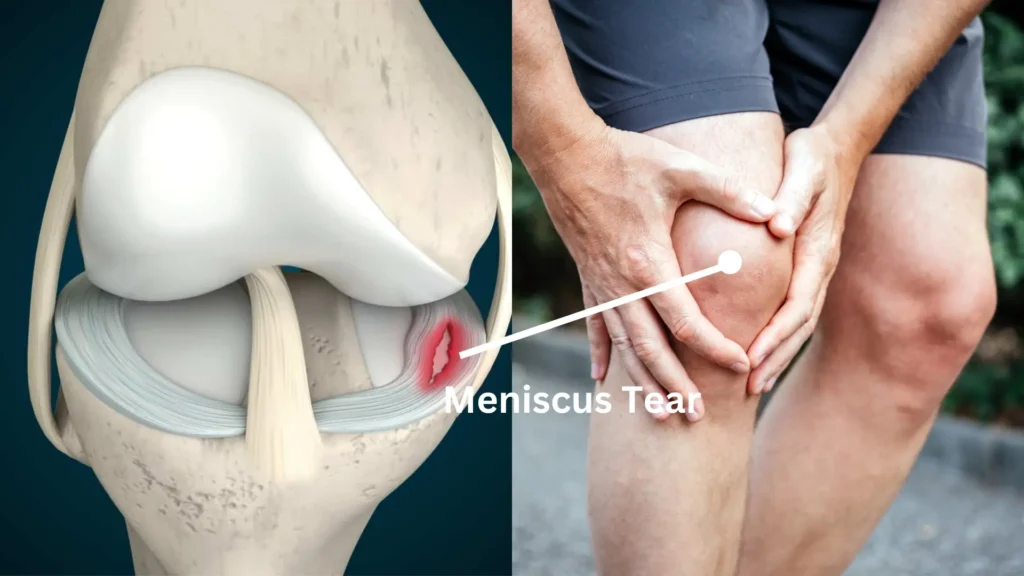Recognizing the signs of a meniscus tear early can help prevent long-term knee problems. Symptoms include:

Doctors typically perform a physical exam followed by imaging tests like an MRI to confirm a diagnosis. Early and accurate diagnosis is key to determining the best treatment plan.
Not all meniscus tears require surgery. Small, stable tears or degenerative tears in older adults often respond well to conservative treatment. Common non-operative options include:
Rest, Ice, Compression, and Elevation can help reduce swelling and manage pain in the early stages of injury.
A guided physical therapy program strengthens the muscles around the knee, improves mobility, and restores function.
Non-steroidal anti-inflammatory drugs (e.g., ibuprofen) relieve pain and inflammation during recovery.
Avoid high-impact or twisting activities until healing occurs. Return to sports should be gradual and guided by a medical professional.
Best for: Minor tears, patients with degenerative changes, or those who prefer to avoid surgery.
Surgical treatment may be necessary when:
Surgeons use small instruments to stitch the torn meniscus back together. This option is ideal for younger patients and tears in the "red zone" (area with good blood supply).
In this procedure, the torn portion of the meniscus is trimmed and removed. It’s minimally invasive and often used when the tear is irreparable.
Reserved for younger patients with previous full meniscus removal and ongoing pain, this involves transplanting donor cartilage.
Q: Can a meniscus tear heal on its own?
A: Some small tears, especially in well-vascularized areas, can heal without surgery.
Q: Is walking good for a torn meniscus?
A: Walking is usually okay if there’s no locking or severe pain, but always consult a physician.
Q: How long is recovery from meniscus surgery?
A: Recovery can range from a few weeks (meniscectomy) to several months (repair or transplant).
If you suspect a meniscus tear, early diagnosis and proper treatment are key to a full recovery. Whether you’re considering non-surgical care or arthroscopic surgery, consult a sports medicine specialist or orthopedic surgeon to create a personalized treatment plan.
What Is a Meniscus Tear? A meniscus tear is a common knee injury that affects the cartilage between the thigh bone (femur) and shinbone (tibia). Each knee has two menisci—medial and lateral—that act as shock absorbers and help stabilize the joint. Tears often occur during sports or physical activity but can also result from wear and degeneration over time.
Recognizing the signs of a meniscus tear early can help prevent long-term knee problems. Symptoms include:

Doctors typically perform a physical exam followed by imaging tests like an MRI to confirm a diagnosis. Early and accurate diagnosis is key to determining the best treatment plan.
Not all meniscus tears require surgery. Small, stable tears or degenerative tears in older adults often respond well to conservative treatment. Common non-operative options include:
Rest, Ice, Compression, and Elevation can help reduce swelling and manage pain in the early stages of injury.
A guided physical therapy program strengthens the muscles around the knee, improves mobility, and restores function.
Non-steroidal anti-inflammatory drugs (e.g., ibuprofen) relieve pain and inflammation during recovery.
Avoid high-impact or twisting activities until healing occurs. Return to sports should be gradual and guided by a medical professional.
Best for: Minor tears, patients with degenerative changes, or those who prefer to avoid surgery.
Surgical treatment may be necessary when:
Surgeons use small instruments to stitch the torn meniscus back together. This option is ideal for younger patients and tears in the "red zone" (area with good blood supply).
In this procedure, the torn portion of the meniscus is trimmed and removed. It’s minimally invasive and often used when the tear is irreparable.
Reserved for younger patients with previous full meniscus removal and ongoing pain, this involves transplanting donor cartilage.
Q: Can a meniscus tear heal on its own?
A: Some small tears, especially in well-vascularized areas, can heal without surgery.
Q: Is walking good for a torn meniscus?
A: Walking is usually okay if there’s no locking or severe pain, but always consult a physician.
Q: How long is recovery from meniscus surgery?
A: Recovery can range from a few weeks (meniscectomy) to several months (repair or transplant).
If you suspect a meniscus tear, early diagnosis and proper treatment are key to a full recovery. Whether you’re considering non-surgical care or arthroscopic surgery, consult a sports medicine specialist or orthopedic surgeon to create a personalized treatment plan.